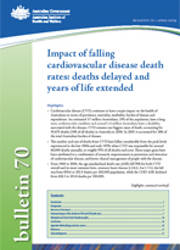Summary
- Cardiovascular disease (CVD) continues to have a major impact on the health of Australians in terms of prevalence, mortality, morbidity, burden of disease and expenditure. An estimated 3.7 million Australians, 19% of the population, have a long-term cardiovascular condition and around 1.4 million Australians have a disability associated with the disease. CVD remains our biggest cause of death, accounting for 45,670 deaths (34% of all deaths) in Australia in 2006. In 2003, it accounted for 18% of the total Australian burden of disease.
- The number and rate of deaths from CVD have fallen considerably from the peak levels experienced in the late 1960s and early 1970s when CVD was responsible for around 60,000 deaths annually, or roughly 55% of all deaths each year. These major gains have been attributed to a combination of research, improvements in prevention and detection of cardiovascular disease, and better clinical management of people with the disease.
- From 1968 to 2006, the age-standardised death rate (ASR) fell 76% for both CVD overall and its most common form, coronary heart disease (CHD). For CVD, the fall was from 830.6 to 201.9 deaths per 100,000 population, while the CHD ASR declined from 428.3 to 101.8 deaths per 100,000.
- The decline in death rates has resulted both in substantial savings of lives and gains in years of life for the Australian population.
- If the age- and sex-specific death rates for CVD and CHD had remained at their 1968 peak, the number of deaths due to these diseases would have been around 4 times as high as the actual number in 2006.
- In 2006, 187,000 Australian lives would have been lost to CVD, rather than the 45,670 actual deaths, representing a saving of over 140,000 lives in that year. More than half of the savings (73,000 lives) are due to declines in the CHD death rate.
- Potential years of life lost (PYLL) is an indicator of premature mortality. The actual PYLL due to CVD in 2006 was 191,600 person-years (assuming an arbitrary life expectancy of 80 years from birth). It is estimated that this figure would have been over 6 times as high, around 1.2 million person-years, if the CVD death rate had remained at its 1968 peak. Similarly, if the CHD death rate had prevailed at the 1968 level, the CHD PYLL would have been 7 times the estimated actual figure of 104,300 person-years.
- It is estimated that, in 2006, the Australian population gained over a million person-years due to the decline in the CVD death rate. Almost two-thirds of this gain (around 656,000 person-years) can be attributed to the fall in the CHD death rate.
- Australians aged 55-64 years may have gained the most from the reduction in CVD and CHD death rates in terms of lives 'saved', while those aged 55-69 years may have benefited most in 'years of life extended' (assuming an arbitrary life expectancy of 80 years).



